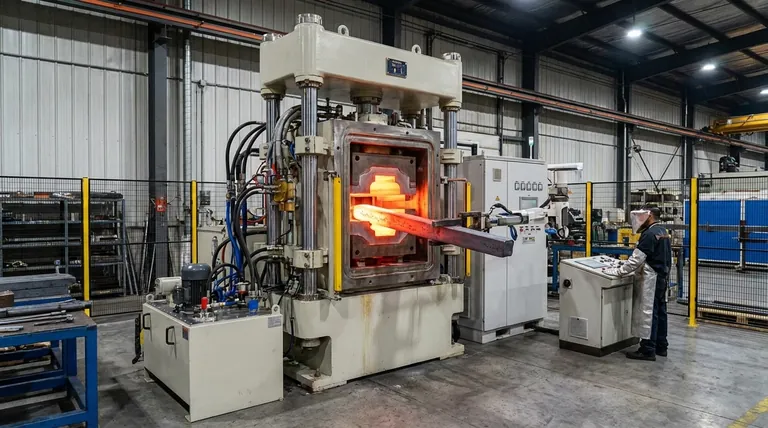In manufacturing, hot press forging is a metal-shaping process where a metal workpiece is heated to an extremely high, malleable temperature before being slowly squeezed into a desired shape by a high-force press. This method uses immense, controlled pressure, often from a hydraulic press, to form the heated metal within a set of dies. It is specifically chosen for creating parts with complex geometries and superior mechanical strength that would be impossible to achieve through other means.
Hot press forging trades some dimensional precision for exceptional material ductility. By heating metal before slowly applying immense force, it allows for the creation of complex, strong components that would otherwise fracture if formed at lower temperatures.

The Mechanics of Hot Press Forging
To understand why this process is chosen for critical applications, it's essential to break down its core components: the heat, the press, and the resulting material properties.
The Critical Role of Heat
The "hot" in hot press forging is the most important element. Heating metal (typically steel, aluminum, or titanium alloys) above its recrystallization temperature makes it significantly more plastic and ductile.
This thermal conditioning allows the material to undergo massive deformation without work-hardening or cracking, which would occur if the same forces were applied at room temperature.
The Application of Force
Unlike hammer forging, which uses rapid impacts, press forging applies a slow, continuous, and controlled squeezing force. This is typically accomplished with a hydraulic press.
The force ratings of these presses are immense, ranging from a few hundred tons to over 80,000 tons for specialized applications. This sustained pressure ensures the metal fully conforms to the shape of the die, even in intricate sections.
The Use of Dies
The heated workpiece is placed between two molds, known as dies. As the press closes, it forces the malleable metal to flow and fill the die cavity completely.
This can be done with open dies for simpler shapes or closed dies (also called impression dies) which fully encase the metal to create a precise, complex, near-net-shape part.
The Cooling Process
After forming, the part must be cooled in a controlled manner. This often involves fixture quenching, where the part is held in a fixture while being rapidly cooled.
This step is critical for locking in the desired metallurgical properties, such as hardness and strength, and minimizing distortion as the part cools.
Understanding the Trade-offs: Strength vs. Precision
Hot press forging is a powerful technique, but it is not the solution for every manufacturing challenge. Its selection involves a clear set of trade-offs between mechanical performance and production considerations.
Advantage: Superior Ductility and Complexity
The primary benefit is the ability to create highly complex geometries. The heated material flows like a thick fluid under pressure, filling every detail of a mold without straining or breaking.
Advantage: Enhanced Material Strength
The forging process refines the internal grain structure of the metal, aligning it with the shape of the part. This creates a continuous grain flow that results in exceptional strength, toughness, and fatigue resistance.
Disadvantage: Higher Cost
Hot press forging is generally more expensive than other methods. The costs are driven by the energy required for heating, the robust and expensive press machinery, and specialized post-processing steps like fixture quenching.
Disadvantage: Lower Dimensional Accuracy
Heating metal causes it to expand, and it shrinks as it cools. This thermal variation, along with the potential for surface oxidation (scale), means that hot-forged parts have less dimensional precision than cold-forged or machined parts. They often require a final machining step to meet tight tolerances.
When to Choose Hot Press Forging
Selecting this process depends entirely on the non-negotiable requirements of the final component.
- If your primary focus is maximum strength and durability: Choose hot press forging for critical, load-bearing parts like engine crankshafts, landing gear, or turbine discs where failure is catastrophic.
- If your primary focus is creating a complex geometric shape: This process is ideal when a part's intricate design cannot be economically machined from a solid block or formed using cold methods.
- If your primary focus is tight dimensional tolerance at the lowest cost: Consider alternative processes like casting, machining, or cold forging, as they may provide a more economical solution for less demanding applications.
Ultimately, hot press forging is the definitive choice when the mechanical integrity and complex geometry of a component cannot be compromised.
Summary Table:
| Aspect | Hot Press Forging |
|---|---|
| Process | Heated metal is slowly squeezed into shape by a high-force press. |
| Key Benefit | Superior material strength and ability to form complex geometries. |
| Primary Use | Critical, load-bearing components (e.g., crankshafts, landing gear). |
| Trade-off | Higher cost and lower dimensional accuracy than some other methods. |
Need to forge superior strength into your critical metal components?
At KINTEK, we specialize in the advanced equipment and consumables that power precision manufacturing processes like hot press forging. Whether you are developing next-generation aerospace parts, durable automotive components, or complex industrial tools, our solutions are designed to meet the demanding needs of your laboratory or production line.
Contact our experts today to discuss how we can support your project with reliable, high-performance lab equipment.
Visual Guide

Related Products
- Vacuum Hot Press Furnace Machine Heated Vacuum Press
- Vacuum Hot Press Furnace Heated Vacuum Press Machine Tube Furnace
- Vacuum Hot Press Furnace Machine for Lamination and Heating
- Electric Heated Hydraulic Vacuum Heat Press for Lab
- 600T Vacuum Induction Hot Press Furnace for Heat Treat and Sintering
People Also Ask
- What is the effect of increasing the pressure during sintering hot press sintering? Optimize Density, Time, and Temperature
- What are the disadvantages of hot pressing? Key Limitations for Your Manufacturing Process
- What is pressure-assisted sintering? Achieve Denser, Stronger Materials Faster
- What happens when you compress hot metal? A Guide to Plastic Deformation & Recrystallization
- What is the hot pressing method of sintering? A Guide to High-Density Material Fabrication



















